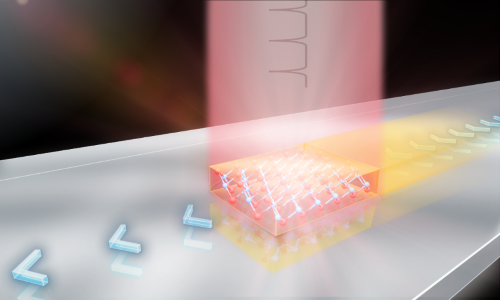Recently, researchers from Shanghai Institute of Optics and Fine Mechanics (SIOM), Chinese Academy of Sciences (CAS) carried out a “two-dimensional (2D) nanosheet actuator” model, of which 2D nanosheets can be manipulated by femtosecond pulsed laser and moved on the horizontal substrate surfaces. This work overcomes the challenge of optically manipulating particles in non-fluid environments. The results of this research were published in Nature Communications on April 14, 2023.
The idea that light carries forces to manipulate particles dates back to Kepler and Newton and was later confirmed by Maxwell. Since the pioneering work by A. Ashkin, the research of optically manipulating micro objects has been attractive in the field of nanoscience and technology. However, these light-induced forces work mostly in vacuum, ambient air and liquids to decrease environmental resistance. Achieving the optical drive for particles in strong van der Waals interactions is still a big challenge, which needs to be addressed in practical applications.
A VSe2 nanosheet was attached to a horizontal polished sapphire substrate via mechanical exfoliation method, and it was completely covered by a vertical pulsed laser beam. When the pulsed laser is applied, the VSe2 nanosheet begins to move and continues moving in the region of uniform illumination. Then moving the light source in the direction towards the nanosheet provides the uniformity of its motion. Because of the substrate, the motion of the nanosheet is limited on a 2D horizontal surface. Comparing different 2d nanosheets, we found that the metal materials with a high absorption coefficient and linear thermal expansion coefficient (such as VSe2 and TiSe2) can be effectively moved in this optical drive system, and the movement efficiency can reach 434 μm×s-1×mW-1.
Through numerical simulation analysis, the existence of an asymmetrical air gap at the interface between two-dimensional nanosheets and substrate contributes to the high-temperature gradient of nanosheet under the irradiation of laser. In this situation, a thermal stress is generated, which is one order of magnitude larger than the friction shear stress and thus can effectively drive the nanosheet. The generated acoustic elastic waves will transmit a part of its momentum to the surface, which translates the nanosheet mass in the direction opposite to that of the wave momentum. The resulting photoacoustic driving mechanism can effectively overcome the strong van der Waals force and friction between the nanosheets and the substrate, and finally realize the free movement of 2D metal nanosheets on the horizontal surface of the sapphire substrate.
This work proposed an optical-driven 2D nanosheet actuator, which effectively expands the application environment of optical manipulation technique and has application potential in optics, machinery, and nanotechnology fields.

Figure 1. Schematic of 2D nanosheet actuator on polished sapphire substrate via femtosecond pulsed laser. (Image by SIOM)